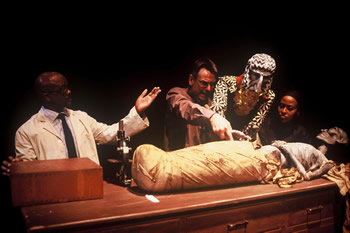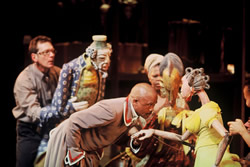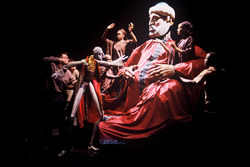
Animating Animals
By Martin Puchner
Tall Horse
By Khephra Burns
Brooklyn Academy of Music
Harvey Theater
(closed)
Tall Horse, which recently played
at the BAM Next Wave Festival, opens with a view of the storage
space of the Musée National in Egypt. On a set of tall shelves,
we find boxes, tools, and sundry objects and fragments. The show
is framed as a history lesson: a Parisian of African descent arrives
at the museum to find the roots of his ancestors' migration to
France in the early 19th century.
Part of this lesson is a preachy lecture
on the French Enlightenment and its search for exotic cultures,
a somewhat diligent combination of Michel Foucault and Edward
Said. But this critique of orientalism does not run very deep,
for the show itself celebrates cultural exchange on every possible
level. It tells the story of a giraffe which is transported 7,000
miles from Alexandria to Paris, a gift from the Pasha of Egypt
to Charles X, King of France. This gift is not a pure act of friendship,
but a ploy in a high-stakes diplomatic game through which the
Pasha wants to turn the King against the Greeks. The cultural
exchange is anything but benign. The makers of Tall Horse,
however, are rather undisturbed by power politics in part because
their production is premised on exchange as well: it is a unique
collaboration between the renowned South African Handspring Puppet
Company and the Sogolon Puppet Troupe from Mali in northern Africa.
Indeed, these two African companies take their artificial gigantic
giraffe on a tour of their own, exhibiting it to gaping audiences
around the world. They, too, are trading in curiosities, and they
seem to enjoy themselves in the process.
The centerpiece of the opening scene is
a mummy, a piece of dead matter. Animating dead matter is the
true purpose of this show--an animation fueled by an exchange
in puppetry. Tall Horse is a play with puppets but also
a play about puppets, an experiment in cross-cultural puppetry.
The Handspring Puppet Company has a long history in innovative
puppetry, including Ubu and the Truth Commission (1998),
an adaptation of Alfred Jarry's Ubu Roi, as well as Claudio
Monteverdi's Return of Ulysses (reviewed
in Hotreview.org in 2004). The Sogolon Puppet Troupe
works with more traditional puppets, in particular simple but
compelling rod puppets as well as antelope puppets with fringed
skirts. The result of this collaboration is a marvelous panoply:
huge puppets such as the Pasha of Egypt or the King's wife; small
puppets representing children; rod puppets creating the impression
of crowds; a diplomat whose long thin legs develop a life of their
own; and a whole zoo of animals, including antelopes, a ferret,
and, of course, the giraffe. The theme of the show, cultural exchange,
is thus translated into a breathtakingly varied inventory of puppets.
The two companies practice their puppet
trade almost to a fault; there are perhaps too many different
types of puppets populating the stage. It is almost impossible
to make sense of the multiplicity of styles and modes, colors
and shapes. In particular the Malian antelope puppets seem to
pop up at odd moments, including at the court in Paris, without
preparation or explanation. It's almost as if the performers and
puppeteers had too much fun exchanging styles and techniques.
 In
the end, however, Marthinus Basson, the show's director, Adrian
Kohler, the main puppet maker of Handspring, and Yaya Coulibaly,
the main puppet maker of Sogolon, manage to turn their rich cultural
resources into a compelling meditation on puppets. There are three
species to be found in Tall Horse: human actors, human
puppets, and animal puppets. The dynamic interrelations among
these are the true drama of this show. Handspring and Sogolon
are masters of animation, but what makes Tall Horse special
is that the animation works both ways: puppets often animate human
actors. One such scene occurs when the French wife of a Marseilles
notable, a puppet who has taken a liking to the human giraffe
caretaker, teaches him how to waltz. Another example is the way
the giraffe leads fashionable Parisian society to imitate it,
an effect beautifully achieved through the long-necked Malian
rod puppets.
In
the end, however, Marthinus Basson, the show's director, Adrian
Kohler, the main puppet maker of Handspring, and Yaya Coulibaly,
the main puppet maker of Sogolon, manage to turn their rich cultural
resources into a compelling meditation on puppets. There are three
species to be found in Tall Horse: human actors, human
puppets, and animal puppets. The dynamic interrelations among
these are the true drama of this show. Handspring and Sogolon
are masters of animation, but what makes Tall Horse special
is that the animation works both ways: puppets often animate human
actors. One such scene occurs when the French wife of a Marseilles
notable, a puppet who has taken a liking to the human giraffe
caretaker, teaches him how to waltz. Another example is the way
the giraffe leads fashionable Parisian society to imitate it,
an effect beautifully achieved through the long-necked Malian
rod puppets.
The animation of puppets (and of humans)
is a matter of grace, but also of power. The huge puppet of the
Pasha of Egypt, for example, is animated by a whole host of puppeteers.
The King of France, though much smaller in size, is surrounded
by a number of attendants, only some of which are puppeteers.
These two royal puppets command these puppeteers, who double as
their underlings. The connection between animation and power is
made clear at the climax of the play, when the giraffe is finally
brought before the King. Even though the King is small (much smaller,
for example, than his wife, who is jealous of the giraffe and
wants to turn it into food) and truly in awe of the animal, he
becomes a sovereign animal trainer, commanding the giraffe and
three antelopes in a final dance. For all its parody of French
society, including its monarch, Tall Horse thus leaves
the power of the King untouched. This monarchist streak is suggested
early on when the giraffe and its entourage encounter revolutionaries
in Lyons. The revolution's main purpose, it seems, is to guillotine
the poor giraffe, and the animal barely escapes. Only after such
hazards have been overcome can the giraffe, which is repeatedly
called a "regal" animal, reach its true destiny and become directly
subservient to the king.
 Even
though pretty much everyone, except for the bad revolutionaries,
is busy protecting the giraffe, the show is not overly concerned
about the animal's welfare. The giraffe is treated as important
only insofar as it is a gift in a political gambit. Early on we
see the mother of the giraffe get hunted, wounded, and killed.
The young giraffe grows up in captivity. The difference between
the wild giraffes and the captured one is expressed in different
styles of puppetry. The parent giraffes are represented by single
performers on stilts, two-legged creatures that move swiftly and
gracefully across the stage. The captured giraffe, whose main
feature is its sheer size, has a huge frame that barely fits the
large stage of the Harvey Theater. Indeed, the performance briefly
relapses into a Foucauldian mode when the French professor goes
about measuring every extremity of the enormous creature. The
giraffe is not only large, but also clunky, something of a machine
that creaks with each awkward step. The only part of this puppet
that can move with some elegance is its long neck, a movement
performed to excess at various moments in the show. At the very
end, after learning that all of Paris is imitating the giraffe,
we are left with an image of the Eiffel Tower, an apt comparison
as the giraffe is indeed a kind of animated architecture. If the
main point of the show is to endow this construction with a soul,
an anima, I am not sure it succeeds. If the point is to stress
compulsion through size and engineering prowess, however, that
works, as we gaze incredulously at this Trojan horse of sorts,
which may harbor one or several humans inside its large belly.
Even
though pretty much everyone, except for the bad revolutionaries,
is busy protecting the giraffe, the show is not overly concerned
about the animal's welfare. The giraffe is treated as important
only insofar as it is a gift in a political gambit. Early on we
see the mother of the giraffe get hunted, wounded, and killed.
The young giraffe grows up in captivity. The difference between
the wild giraffes and the captured one is expressed in different
styles of puppetry. The parent giraffes are represented by single
performers on stilts, two-legged creatures that move swiftly and
gracefully across the stage. The captured giraffe, whose main
feature is its sheer size, has a huge frame that barely fits the
large stage of the Harvey Theater. Indeed, the performance briefly
relapses into a Foucauldian mode when the French professor goes
about measuring every extremity of the enormous creature. The
giraffe is not only large, but also clunky, something of a machine
that creaks with each awkward step. The only part of this puppet
that can move with some elegance is its long neck, a movement
performed to excess at various moments in the show. At the very
end, after learning that all of Paris is imitating the giraffe,
we are left with an image of the Eiffel Tower, an apt comparison
as the giraffe is indeed a kind of animated architecture. If the
main point of the show is to endow this construction with a soul,
an anima, I am not sure it succeeds. If the point is to stress
compulsion through size and engineering prowess, however, that
works, as we gaze incredulously at this Trojan horse of sorts,
which may harbor one or several humans inside its large belly.
There is one relation that functions seemingly
outside the question of politics and diplomacy, namely that between
the giraffe and its caretaker, Atir. They alone truly understand
one another, and in the end Atir chooses to remain with the animal
in Paris rather than return to his village. The show ends with
the giraffe gently kicking the sleeping Atir, as if attempting
a final act of animal-human animation. Atir moves a little, but
falls back asleep, leaving us to ponder that huge mechanical creature,
brought all the way from Africa not only to Paris but to New York.
Who could fail to be impressed by the accomplished puppetry, the
fertile exchange of cultures, and the power of animation. But
we are also left to wonder what kind of lesson we can take away,
a lesson not so much about the French Enlightenment, curiosities
and diplomacy, but about the act of animation itself, from which
this show derives its pulse. This animation has a limited understanding
of animals. Its plot is too confined by a conception of animals
as something to marvel at, trade, give as gifts, transport over
large distances, and put into the royal menagerie. Of the three
species--humans, human puppets, and animal puppets--the latter
occupy the center of attention, but not the center of animation.
One is left wondering what it would look like if the regal animal
took over and in turn animated human puppets and human actors.
